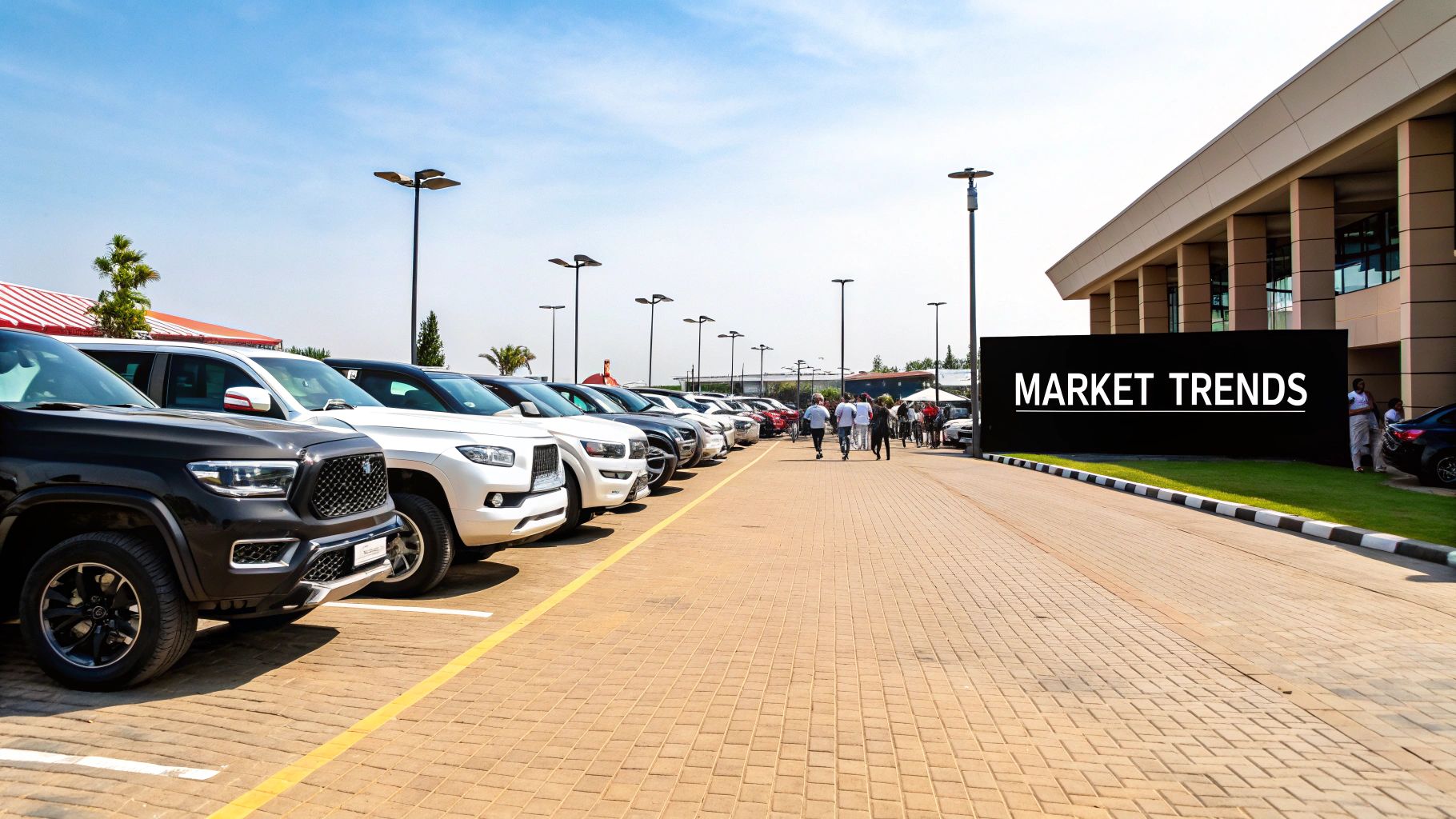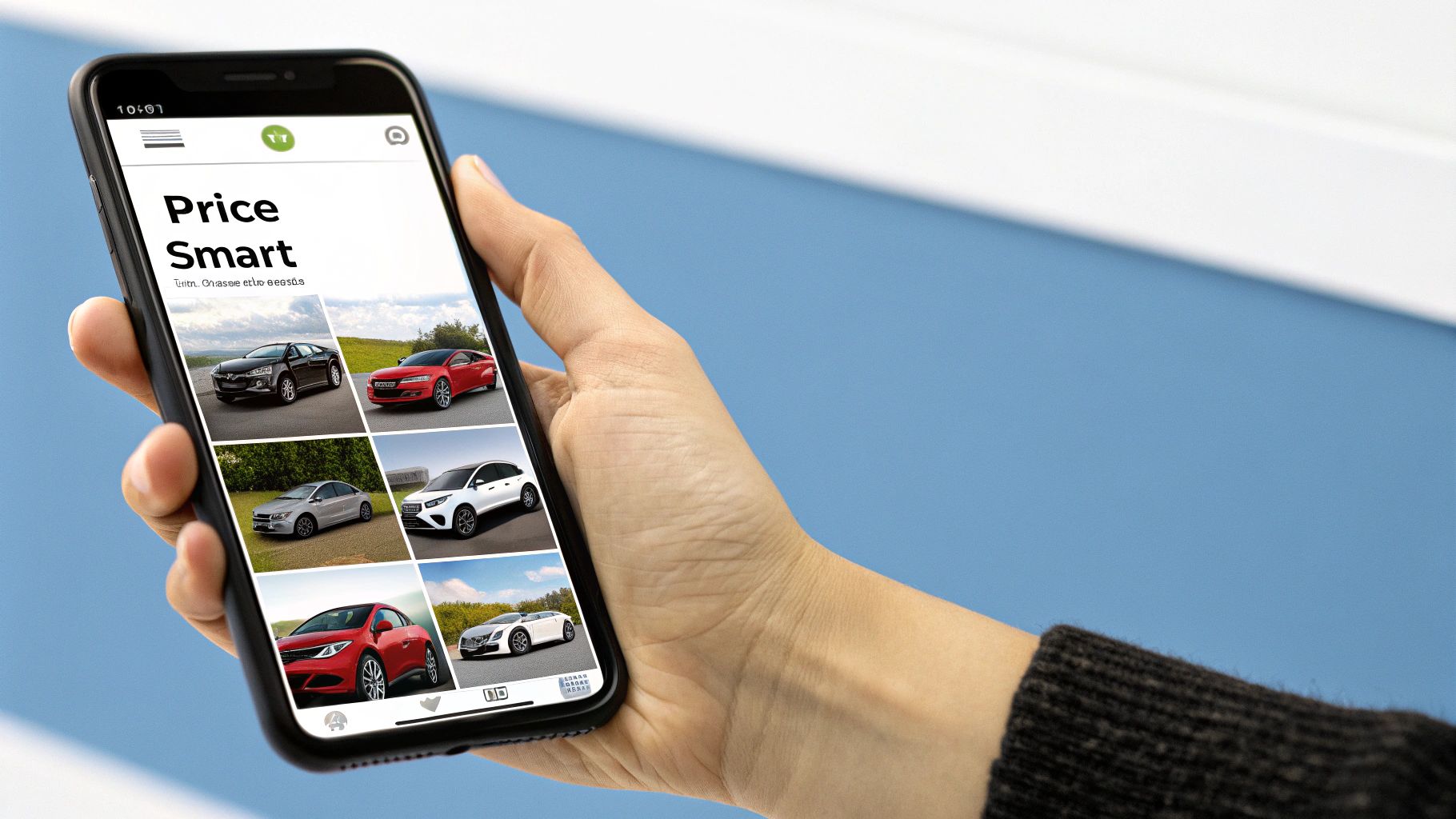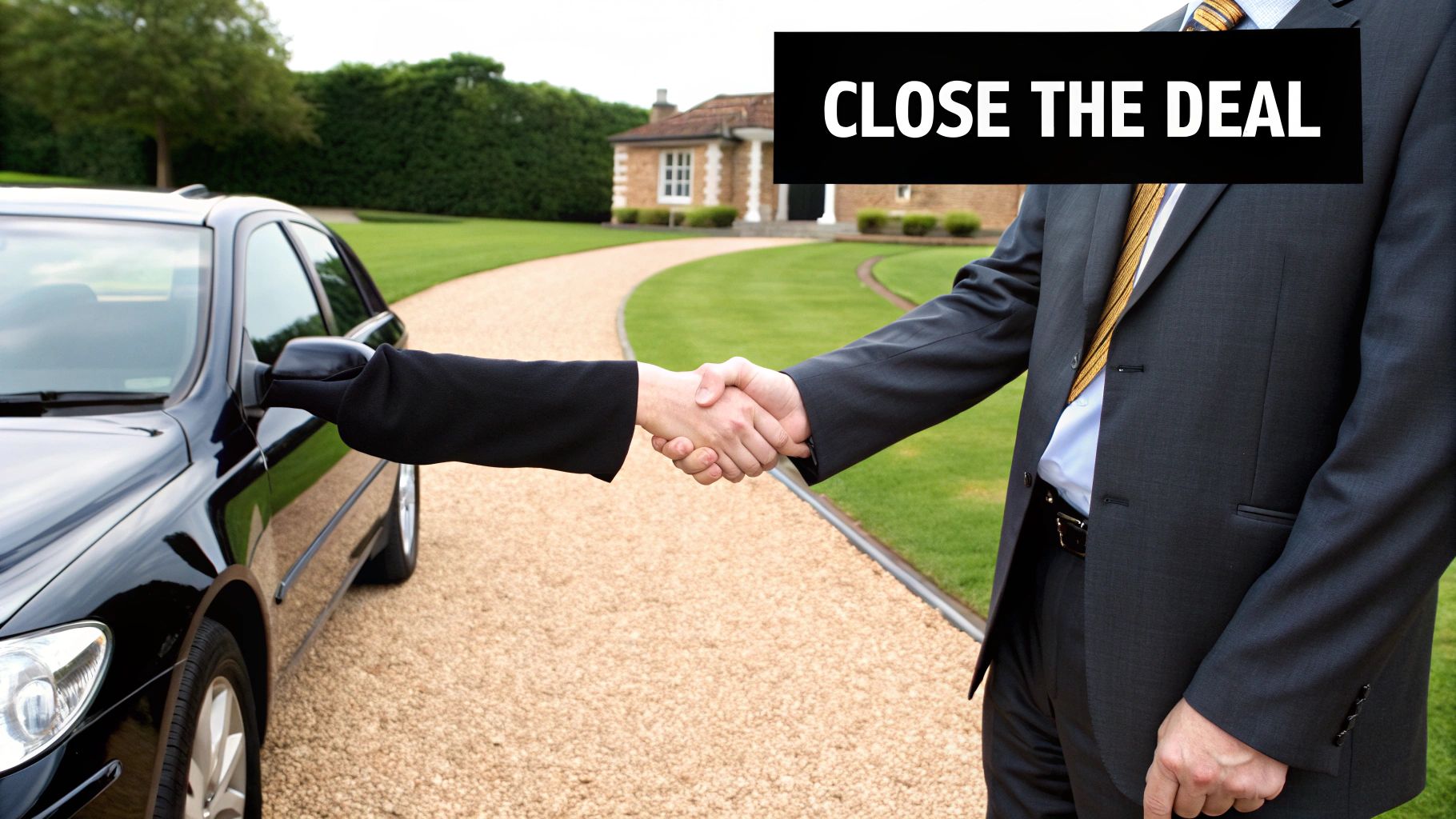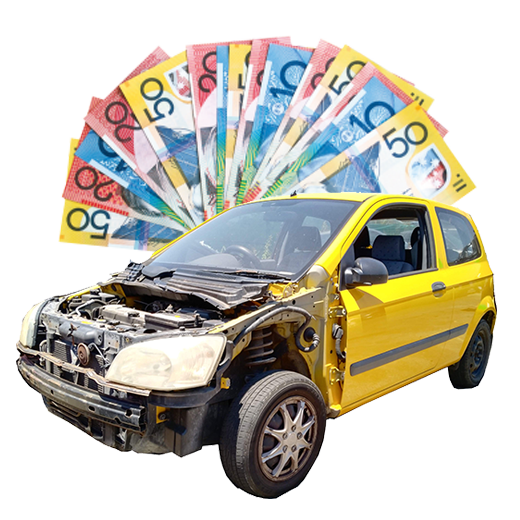Deciding on the best way to sell your car in Australia really boils down to what you value most. If getting the absolute highest price is your goal, a private sale is hard to beat. But if you're after sheer speed and zero hassle, a dealer or a car removal service is the way to go. It's all about finding that sweet spot between the cash in your hand and the effort you’re prepared to invest.
Reading the Australian Car Market

Before you even think about writing an ad, you need a solid grasp of the current Australian car market. This isn't just a "nice-to-have"; it's crucial for setting a price that's both realistic and gets your car sold quickly. The automotive world is constantly changing, and those shifts have a direct impact on your final sale price.
Think about it this way: if you're selling a popular ute like a Ford Ranger or Toyota HiLux, you're already in a great position. These models are perennial best-sellers, which means demand is high and buyers have less power to haggle you down. On the flip side, selling a small sedan or hatchback in today's market calls for a completely different game plan.
The SUV and Ute Domination
A quick look at the sales data reveals a very clear story about what Aussies are driving off the lots. The market is absolutely dominated by SUVs and Light Commercial Vehicles (LCVs), and this trend has major implications for anyone selling privately.
In June 2025 alone, SUVs made up a staggering 58.9% of all new vehicle sales. Utes and other light commercials snapped up another 24.3%. When you add it up, that's over 80% of the entire market. Traditional passenger cars? They're left with just a 12.9% slice.
What does this mean in practical terms? If you're selling an SUV or a ute, you should be shouting about its practicality, space, and go-anywhere versatility—all the things current buyers are looking for. If you've got a sedan, you'll want to focus your pitch on its fuel economy, cheaper running costs, and how easy it is to park in the city to attract that smaller, but still very motivated, group of buyers.
What This Means for Your Sale
Knowing these market trends is your secret weapon. It helps you position your car in the best possible light, moving beyond a simple list of features to telling a story that resonates with today's buyers.
- For in-demand models: You're in the driver's seat. You can price your car with confidence at the upper end of its market value, knowing a large pool of buyers is actively searching for it.
- For less popular models: Smart pricing is everything. You'll need to do your homework and look at comparable listings to make sure your price is competitive enough to get noticed.
Ultimately, understanding where your vehicle sits in the grand scheme of things is the foundation of a successful sale. It informs your ad, helps you prepare for questions, and allows you to walk into negotiations feeling knowledgeable and prepared. Our detailed guide on where to sell your vehicle can help you pick the perfect platform for your specific type of car.
Prepping Your Car to Get the Best Possible Price
First impressions count for a lot, and when it comes to selling your car, they can directly impact the final number on that cheque. Don't think of it as just cleaning; it's about strategic presentation. Every little detail you get right gives a buyer one less reason to haggle you down. The secret to getting top dollar is making your car look and feel like it’s worth every cent.
This isn’t about a quick trip through the car wash. It's about focusing on the things that buyers notice, even if they don't realise it. A car that gleams inside and out sends a powerful message: "I've been looked after." That alone builds a huge amount of trust right from the get-go.
Zero in on What Really Matters
Start with a really good wash, but don't stop there. Get into the details. Clean the wheels and rims properly and give the tyres a bit of shine. If you want to go the extra mile, a clay bar treatment will pull off all the embedded grime from the paintwork, leaving a finish so smooth it feels like glass. It really makes the colour pop.
Next, have a look for those little cosmetic issues. You’d be surprised what you can fix yourself with a quality polish and a bit of effort. Buffing out minor scratches and swirl marks can take years off a car's appearance.
This isn't just theory; putting in a little effort here translates directly into more cash.

As you can see, fixing up those scratches can add an average of $600 to your sale price. That's a massive return for a Saturday afternoon's work.
The inside is just as important. A proper interior deep clean means:
- A serious vacuum: Get under the seats, in the boot, and into every nook and cranny.
- Wiping every surface: The dashboard, centre console, and door panels collect more dust and grime than you think.
- Crystal clear windows: Clean them inside and out with a good streak-free cleaner.
- Get rid of smells: Lingering odours from pets, food, or smoke are a major turn-off. An odour eliminator or a simple airing-out can work wonders. A neutral, fresh scent is what you're aiming for.
Here’s a pro tip: pop the bonnet and clean the engine bay. So many sellers skip this. You don't need to be a mechanic – just a quick degrease and wipe-down makes a world of difference. It screams "meticulously maintained" and gives buyers confidence that you've cared for the car properly.
Get Your Paperwork in Order
You can have the cleanest car on the block, but if your paperwork is a mess, you'll undermine all your hard work. Having everything organised shows you're a transparent and serious seller, which buyers really appreciate.
Grab a folder and pull together all the important documents.
- Service History: This is your golden ticket. A fully stamped logbook is probably the single most powerful tool you have for justifying your price.
- Registration Certificate: Make sure it’s current and you know exactly where it is.
- Owner's Manual: It's a small thing, but buyers like getting the original manual.
- Major Receipts: Got new tyres recently? Replaced the timing belt? Find those invoices and include them.
When you hand over a neat folder with a complete history, it instantly builds credibility. It removes doubt from the buyer's mind and makes them feel secure about the purchase, which makes them far more likely to meet your asking price.
Getting Your Price Right and Crafting a Killer Ad

Pricing your car is a bit of an art. If you ask for too much, your phone will stay silent. Go too low, and you're leaving cash on the table. Finding that sweet spot is the first, and most crucial, step to selling your car without a fuss.
A great starting point is to see what online valuation tools suggest. Websites like RedBook or the valuation feature on Carsales can give you a solid ballpark figure. Think of this as your baseline.
But a computer can't see the little things – the immaculate interior of your car, or the local demand for your specific model. That's why your next step is to play detective. Jump online and search for cars just like yours: same make, model, year, and similar kilometres. This real-world recon is where you fine-tune your price from a good guess to a competitive asking price.
Writing a Description That Actually Sells
With your price sorted, it's time to write an ad that grabs attention. A good description does more than just list features; it builds a picture in the buyer's mind and, more importantly, builds their trust in you. Your headline should be punchy and clear, including the essentials: year, make, model, and one standout feature like "Low KMs" or "Full Service History".
In the ad itself, be detailed and honest. Don't just tick a box for "air conditioning" – tell them it's "ice-cold" and ready for a hot Adelaide summer. Instead of just "new tyres," mention the brand and that you had them fitted only 5,000 km ago.
Think of your ad's description as your first negotiation. Being upfront about the good (a recent major service) and the not-so-good (a small scuff on the bumper) is a game-changer. It weeds out the tyre-kickers and brings in serious buyers who value your honesty.
Be sure to highlight what makes your car a great buy. Did you upgrade the sound system? Is it ridiculously good on fuel? These are the little details that will make a buyer pause their endless scrolling and focus on your listing. For a deeper dive, our guide on how to sell a vehicle privately has even more pro tips for writing copy that converts.
Taking Photos That Stop Scrollers
Let's be honest: in online car sales, photos are everything. People see your car long before they read about it. Dark, blurry, or messy pictures are an instant turn-off and the quickest way to have your ad completely ignored.
You don’t need a fancy camera; your smartphone will do the job perfectly. The secret is the setup. Find a clean, uncluttered background (an empty car park or a quiet park works well) and aim to shoot during the "golden hours"—that soft, flattering light just after sunrise or before sunset.
Give potential buyers a complete virtual tour. Your photo gallery should be comprehensive.
- The Full Picture: Get shots from all four corners, plus straight-on from the front and back.
- A Look Inside: Snap the dashboard, front seats, back seats, and the boot space.
- The Details Matter: Get close-ups of the odometer (showing the KMs), the wheels and tyres, and any special features.
- Proof in the Pudding: A clear photo of your service logbook with all its stamps is one of the most powerful trust signals you can provide.
Combine smart pricing with a great story and top-notch photos, and you won’t just get views—you’ll get serious calls from people ready to make a deal.
Mastering Buyer Interactions and Negotiations

Right, this is where all your prep work really starts to pay off. Dealing with phone calls, test drives, and the inevitable haggle can feel a bit daunting, but if you go in with a plan, you'll be the one in the driver's seat—pun intended. The trick is to handle every interaction professionally, right from that first phone call.
When the enquiries start rolling in, your first task is to sift through them. You need to quickly figure out who's a serious buyer and who's just a tyre-kicker. A genuine buyer will usually ask detailed questions about the car's service history or its condition, not just "what's your best price?". Don't be shy about asking a few questions of your own to see how serious they really are.
Handling Calls and Screening Buyers
Having a rough script in your head can stop you from getting flustered. A great opening line when someone calls is to politely ask if they've had a chance to read the full ad. It's a simple question, but it immediately filters out anyone who hasn't bothered to do their basic homework.
Next, be ready to answer their questions openly and honestly. This is why you organised all that paperwork earlier! Being able to quickly give a specific date for the last service or when the tyres were replaced builds a huge amount of trust. That kind of confident, transparent approach is what separates a frustrating experience from the best way to sell a car privately.
The Test Drive Safety Checklist
The test drive is a massive part of building trust, but let's be clear: your safety is the number one priority. Never, ever hand over your keys without setting some firm ground rules first.
- Verify their identity: Always ask to see their driver's licence. Snapping a quick, discreet photo of it on your phone is a smart move.
- Check your insurance: Before anyone drives your car, give your insurer a quick call to confirm your policy covers other drivers. Most comprehensive policies do, but it's not worth the risk to assume.
- Ride along: This is non-negotiable. You should never let a stranger take your car for a spin alone. Going with them also gives you a chance to point out the car's best features and answer questions as they pop up.
The goal here is to make the buyer feel comfortable and confident in the car, while you remain completely in control of the situation. A smooth test drive experience can make all the difference.
Confident Negotiation Tactics
Negotiating doesn't need to be a confrontation. If you've done your homework and priced the car fairly, you can be confident in its value. You will get low-ball offers; it's just part of the process.
Instead of getting annoyed, have a calm, polite response ready. Something like, "Thanks for your offer, but based on its excellent condition and full service history, I'm firm on a price closer to my asking." This simple line cleverly steers the conversation back to the car's value, not just the price tag.
And remember, you're tapping into a massive market. Recently, 415,300 vehicles were sold to private buyers in Australia, making up more than a third of all sales. These are people looking for a good, honest car from a trustworthy seller. By highlighting your car’s best points and having the records to back it up, you’re giving them exactly what they want and putting yourself in the best position to get a great price. You can always dig deeper into these trends and see detailed monthly sales data to understand the market better.
Finalising the Sale and Handling the Paperwork
You’ve made it through the ads, the tyre-kickers, and the test drives. You've even shaken hands on a price. Now for the most important part: making sure the sale is buttoned up, legal, and that you're completely free from any future headaches. This is where crossing your T's and dotting your I's really matters.
First things first, you need a proof of sale. This doesn't have to be a complicated legal document drafted by a solicitor. A simple, clear receipt or a basic contract of sale is all it takes. Think of it as your get-out-of-jail-free card if any disputes pop up later on.
A good receipt should have these key details:
- Your full name and address
- The buyer's full name and address
- The car's vitals: make, model, year, VIN, and rego number
- The final sale price you both agreed on
- The date the transaction happened
- The magic words: a clause stating the car is sold "as is, where is". This is crucial for protecting you from future claims about the car's condition.
Make sure you and the buyer both sign two copies of this receipt—one for you, one for them. It might seem like a small thing, but this simple piece of paper is your best defence if the legitimacy of the sale is ever questioned.
Managing Payment and Transferring Ownership
Let’s talk about the money. Getting paid securely is non-negotiable. While a stack of cash can feel satisfying, it's also a risk to carry around. I've found that a direct bank transfer or a secure instant payment system like PayID is a much safer bet.
Here's the golden rule: Never hand over the keys or sign the transfer papers until the money is cleared and sitting in your bank account. It's not unheard of for scammers to show you a fake payment confirmation screen. Wait until your bank app says the funds are well and truly there.
Once you’ve confirmed the payment, it's time to officially transfer ownership. You'll need to fill out the seller's section on your car's registration certificate, and both you and the buyer will need to sign it.
The last thing you absolutely must do is lodge a Notice of Disposal. This is your legal duty as the seller, and you need to do it quickly. This notice tells the state transport authority that the car is no longer yours, which protects you from any speeding fines, parking tickets, or toll charges the new owner might rack up. If the paperwork feels a bit much, remember that professional services for the disposal of cars can handle this for you, making it a completely stress-free experience.
By taking care of these final steps, you can hand over the keys with total peace of mind, knowing the deal is done right and you're legally in the clear. You’ve successfully closed the chapter on your old car without leaving any loose ends.
Got Questions About Selling Your Car? We've Got Answers
Even when you know the basic steps, selling a car can throw up a few curly questions. It’s easy to get tangled up in the state-specific rules and common little hurdles that pop up along the way. Getting these details right is key to protecting your time and, more importantly, your back pocket.
Let's dive into some of the most common queries we get from sellers all over Australia.
A big one is always about timing. Is there a "best" time to sell? Honestly, while you might see a bit more interest leading up to holidays or around tax time when people have extra cash, it's not a deal-breaker. A good car that’s presented well and priced fairly will find a buyer any day of the year.
Do I Really Need a Roadworthy Certificate?
This is a classic "it depends" situation, as the rules for a Roadworthy Certificate (RWC), or safety certificate, change the moment you cross a state border.
In places like Queensland and Victoria, providing an RWC is usually the seller's responsibility and a legal must-have. Head over to South Australia, though, and it’s a different story; for most private sales, it's not required by law. The onus falls on the buyer.
Even if you don't legally need one, getting an RWC can be a brilliant move. It screams "I've looked after this car," giving buyers a massive boost of confidence. This small investment can often help you stand firm on your asking price and seal the deal faster.
What Happens to My Leftover Rego and Insurance?
When the car sells, what about the registration you've already paid for? You’ve got two choices. You can either sell the car with the remaining rego as a nice little bonus for the buyer, or you can cancel it and claim a refund for the unused time.
If you leave the rego on, make sure you lodge the notice of disposal the second the sale is done. You don't want to be on the hook for the new owner's speeding tickets.
Insurance is much more straightforward. Once the deal is done and the money has cleared, simply ring your insurer to cancel the policy. They’ll usually calculate a pro-rata refund for the premium you haven't used.
A crucial tip: Never, ever cancel your insurance before the car is officially sold and out of your hands. You absolutely need to be covered for those final test drives and right up until the new owner drives it off into the sunset.
The Australian car market is always evolving, too. We're seeing a huge rise in Chinese brands, and the electric vehicle scene is constantly shifting buyer tastes. While selling an EV might appeal to a niche audience, your trusty petrol and diesel vehicles—especially the ever-popular utes and SUVs—are still your safest bet for a quick sale to the widest pool of buyers. For a deeper dive, check out the latest analysis of the Australian car market on Focus2Move.
So, should you trade it in or sell it privately? It boils down to one thing: what do you value more? A trade-in is quick and painless, but you'll nearly always get less money for your car. If getting the best possible price is your top priority, a private sale is still the undisputed king.
If juggling the prep work, advertising, and endless negotiations sounds like a headache you’d rather avoid, Auto Removal Adelaide makes it simple. We buy your unwanted car for instant cash, take care of the paperwork, and tow it away for free anywhere in Adelaide. Find out how much your car is worth with a no-obligation quote and get instant cash today at https://autoremovaladelaide.com.au.


